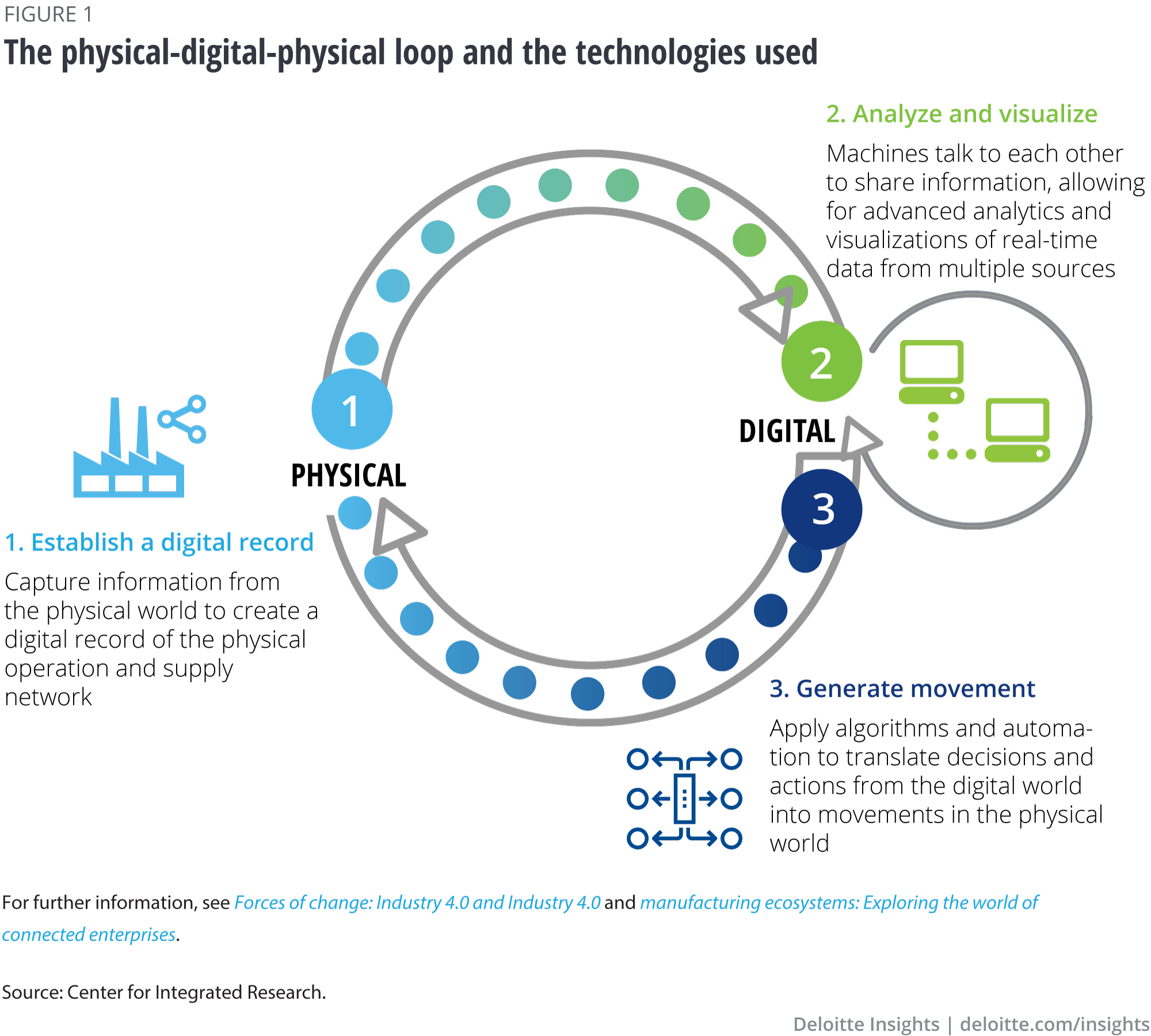
Tax governance in the world of Industry 4.0 Adapting global tax regulation for connected enterprises
15 minute read
27 August 2018
 Gianmarco Monsellato France
Gianmarco Monsellato France Gareth Pritchard United Kingdom
Gareth Pritchard United Kingdom Debbie Hatherell United Kingdom
Debbie Hatherell United Kingdom Lorraine Young United Kingdom
Lorraine Young United Kingdom
Industry 4.0 is changing the speed investment decisions are made. That means tax regulators and business leaders must understand how to develop and implement regulations and strategic growth plans while working with governments to create global solutions.
The necessity of an updated tax system
Industry 4.0 has rapidly become a global priority for enterprises and governments alike due to multiple benefits: It can enable developed nations to reindustrialize, and it can lower the barriers to entry for developing nations. Realizing these benefits, however, necessitates a profound transformation in business models: from economies of scale to on-demand manufacturing; from standardization to mass customization; from a linear, reactive supply chain to an agile, connected organization that can anticipate and respond to changes in the market.1
Learn more
Read more from the Industry 4.0 collection
Subscribe to receive related content from Deloitte Insights
This article is featured in Deloitte Review, issue 24
Create a custom PDF or download the issue
While we are beginning to understand the economic, business, and social impacts of these changes,2 the impact of Industry 4.0 on tax policies is still largely ignored. The foundations of the current international tax system were built a century ago to address the changes of the Second Industrial Revolution, and have been updated only slightly to address the changes brought forth by the Third. Historically, tax systems have been developed to reflect the cost optimization strategies defining industries during the 20th century.3 Examples vary, from tax incentives for investment, to transfer pricing regulations targeting complex supply chains.
The Fourth Industrial Revolution, however, brings with it profound change. New industrial strategies are based on revenue, not cost. And that revenue comes from multiple sources, with supply chains growing leaner, more customized, and flexible in the face of an on-demand economy. Our international tax system is simply no longer fit for an age where predictive maintenance, artificial intelligence (AI), and smart factories rule the day.
How can an international tax system built around the traditional model of manufacturing cost-saving strategies deal with a data-driven, connected, and self-adaptive network? It can be challenging for regulators to adapt the tax system to adjust to—and foster the growth of—Industry 4.0. This gap between what the new industrial model needs and the ability of tax policymakers to keep pace with change triggers substantial risks of multiple taxation that will be detrimental to industrial companies.4
What is Industry 4.0?
The concept of Industry 4.0 incorporates and extends digital connectivity within the context of the physical world in digital enterprises and digital supply networks. This drives the physical act of manufacturing, distribution, and performance in an ongoing cycle known as the physical-digital-physical (PDP) loop (see figure 1).
Industry 4.0 technologies combine information from many different physical and digital sources and locations, including the Internet of Things (IoT) and analytics, additive manufacturing, robotics, high-performance computing, AI and cognitive technologies, advanced materials, and augmented reality.
Throughout this cycle, real-time access to data and intelligence is driven by the continuous and cyclical flow of information and actions between the physical and digital worlds. Many manufacturing and supply chain organizations already have some portions of the PDP loop in place, namely, the physical-digital, and digital-digital processes. However, it is the leap from digital back to physical—from connected, digital technologies to action in the physical world—that constitutes the essence of Industry 4.0.

This article examines three different Industry 4.0 scenarios that reflect the magnitude of the challenges ahead:
- The shift from just-in-time to on-demand manufacturing;
- The rise of aftermarket support; and
- The shift from products to data-driven services.
While each Industry 4.0 scenario described in this article brings with it a set of unique tax challenges for both business executives and policymakers, certain policy questions remain consistent across all, as described below:
- Direct tax. Historically, current transfer pricing regulations and approaches have been developed to address traditional linear supply chains, with clearly defined roles for entities and the sale of goods between them. As supply networks become less centralized and more interconnected, it will be vital to consider where value is generated in a supply chain, how or where the value should be taxed, and which entity should be liable for the tax.
- Indirect tax. Organizations must consider whether new establishments (i.e., fixed places of business) will be created globally, the nature of what is being supplied (i.e., goods or services), and what this means for their global value-added tax (VAT) compliance. For VAT purposes, most services are treated as supplied where the recipient is located, which can be a challenge where data generation and data analysis are performed in separate locations. Similarly, the rules regarding the supply of both goods and services create different compliance and reporting obligations.
- Employment tax. As workers find new roles and new ways of working in an Industry 4.0 ecosystem,5 tax considerations will vary by use case.
Tax regulation will adapt, eventually. The shift will likely be slow and inconsistent from one region to another. But by understanding the specific ways in which Industry 4.0 technologies shift the way businesses operate, policymakers and executives alike can begin to consider ways tax policy will need to adapt to the Fourth Industrial Revolution.
Shifting from “just-in-time” to “on-demand”
Inventory management has, for many years, been a key determining factor in the success of manufacturing businesses. In the 1980s, the Kanban method6 of lean manufacturing was developed in the automotive industry to optimize inventory costs and manage risks of obsolescence. This methodology tied manufacturing and distribution strategy to the anticipated delivery date, with the aim of delivering on time while reducing inventory stock. The use of this scheduling system for just-in-time manufacturing became widespread and resulted in businesses holding stock on a regional basis for both finished and partly-manufactured goods.
In this approach, supply chain management became a key success factor. The process required regional centralization of inventory for both semi-finished and finished goods, as well as centralized order processing and centralization of financial flows, and triggered successive intercompany sales linked to sophisticated transfer pricing. In this linear process, taxation followed the successive intercompany sales from plants to clients, passing through centralized purchases centers and distributors near the client. Our current international tax system still lives in this world, where transfer prices of goods are an essential part of tax policies and tax audits.
On-demand manufacturing leads to sourcing complexity. Industry 4.0 does not conform to this predictable, linear supply chain, however. Rather, it encourages and rewards on-demand manufacturing and connected systems that produce goods based on data about clients’ preferences, behaviors, and demands. As such, supply chains, production, and demand have become more complex and fragmented; products can be sourced from a variety of different suppliers, goods can be shipped to and from a variety of different countries, and customization is increasingly expected at the local or even individual level.7
Vendor sources may not always be known in advance, and may be selected at the last moment from a qualified pool of vendors, each of which may be located in different countries and subject to different indirect tax rules. Further, some transactions and flows of goods may be liable to customs duties, while others are not. As vendors may not be selected until the last moment, each must have a tax profile ab initio.8 As such, enterprise resource planning (ERP) systems must be able to account for a much larger diversity of tax profiles for vendors—and those profiles must be audited regularly.
Direct from the source. Even as they grow more complex in some instances, supply chains are also simplifying and shedding layers on others, as consumers find they may go directly to the factory or supplier for goods. This is already prevalent in the consumer business sector, with products such as coffee capsules, whiskey, and biscuits available directly from the manufacturer.9 This suggests that manufacturers may make deliveries to countries where they have no physical presence, increasing VAT liabilities. Procedures for nonresident VAT payers are complex, and can represent a cash flow burden.
TAX IMPLICATIONS FOR ON-DEMAND MANUFACTURING: QUESTIONS AND CONSIDERATIONS
Direct tax. As they operate in more flexible and interconnected supply networks,10 business leaders and policymakers should consider the following questions: How will jurisdictions adapt their tax and transfer pricing rules to deal with situations where the supply chain changes as needed? As supply networks become less centralized, and data is harvested from across various entities, where is the value to be taxed? Is the value in the data itself, the monetizing of the data, or the technology that creates the data? If many parts of the group contribute to collecting and analyzing data, what method should be used to allocate profits between them? Will this even be practical when the nature, amount, and value of data changes daily?
Indirect tax. With direct-to-consumer supply chains, manufacturers may be transacting in countries where they are not established, exposing them to VAT-related interest and penalties. For additive manufacturing, is there a digital good crossing border or should one only consider the tangible product location once printed? The process for determining the correct tax treatment can become significantly more complex when a tax team is dealing with a fluid pool of suppliers, in additional jurisdictions with differing rules. On-demand manufacturing also results in the need for manufacturers to make faster decisions regarding the appropriate tax treatment.
Tax authorities have recognized and are seeking to address the challenges that arise due to on-demand manufacturing. For example, the European Commission announced that businesses selling goods online will be able to function as providers of e-services. Thus, rather than creating VAT registrations in each member state to which goods are sold, a single VAT registration can be held through which VAT is automatically accounted for to the correct authority. Along with lower compliance costs and administrative burdens for businesses, an estimated 7 billion EUR (more than US$8 billion) of additional VAT revenue will be generated across the European Union annually.11 In the future, however, can authorities ensure that such measures apply to all direct-to-consumer sales contemplated by manufacturers?
Employment tax. Finding the right talent with the skills to use advanced technologies may be difficult, so the selection of future supply chain locations may be driven increasingly by the availability of talent.12 At the same time, virtual and/or augmented reality technologies may facilitate remote interaction, reducing the need for staff mobility across regions and so easing associated employment tax reporting requirements.
The perils of double taxation in the aftermarket
Industry 4.0 allows manufacturers to shift their focus away from the initial sale of a physical product to a recurring revenue model, in the form of aftermarket support and maintenance.13 Connected products provide a constant stream of data back to the manufacturer, and by analyzing this data, manufacturers can begin to anticipate demand, and enable capabilities such as predictive maintenance.14 In this way, the data provides opportunities to create additional value—and recurring streams of revenue—through complementary products and services. Concluding the sale is therefore no longer the end of a commercial process, but the first step toward a recurring flow of business.15
However, current international tax systems mainly address commercial development cycles of an earlier era. Historically, companies have tended to research new markets or revenue opportunities through preliminary studies and have tested the scale of the market through an agent before deciding to create a sales subsidiary. Traditionally, direct taxation has usually followed a similar, linear breakdown: starting with non-taxation for exploratory activities because they do not generate material revenue; continuing with partial taxation that is limited to the agent margin; and ending with full taxation of the distribution activities.
Industry 4.0 technologies enable businesses to focus more on the aftermarket than prospection. Indeed, tax regulators have acknowledged that the digital economy does not follow this traditional standard anymore, with resulting issues such as defining the tax jurisdiction and attributing value to data.16 The tax authorities in each user’s country want to ensure taxation in their territories, which can limit their perspective vis-à-vis Industry 4.0 capabilities.
TAX IMPLICATIONS FOR THE AFTERMARKET: QUESTIONS AND CONSIDERATIONS
Direct taxes. When the sale of a product today drives the sale of complementary goods or services tomorrow, how will aftermarket sales be taxed—and who will be liable for that tax? Further, is part of the product sale attributable to the aftersales service, or is the reverse true? Are aftermarket services considered accessories to the initial sale, and therefore taxable at the place of distribution? This question will be particularly relevant in situations where product sales and aftermarket sales take place in different jurisdictions, a client may be generating data in a third location, and data may be analyzed in yet another location. In these cases, where are the services taxed? Further complicating matters, how can the data itself and its analysis—both of which are critical to the aftersales service— be valued and taxed, particularly if the analysis is automated and does not require human input?
Further, if an element is attributable to the aftersales service, and therefore the intellectual property (IP) on which it depends, an implicit license and royalty payment may be subject to withholding tax in the country where the data is collected. In this case, a significant risk of double taxation exists, as different jurisdictions take different approaches to IP qualifications and a globally consistent approach does not exist. Double taxation treaties and the wider international tax corpus have so far failed to keep pace with these developments.
Indirect tax. A variety of factors must be considered when determining whether aftermarket supplies constitute separate supplies, making them subject to VAT. For example, some indicative factors include the number of suppliers involved, a typical customer’s perception of what is being purchased, the contractual terms, and the economic reality of the transaction. Some of these considerations, such as consumer perception, can be subjective and lead to uncertainty.
From a regulatory perspective, tax authorities have recognized this dilemma and are starting to act upon it. For example, “Fair taxation of the digital economy,” proposed in March 2018, proposes new rules defining how a business can create a significant digital presence in a member state for direct tax purposes.17 However, such a distinction in establishment terms is yet to exist for indirect tax.
Employment tax. As aftermarket customer bases go global, the emergence of the “gig economy”— workers who use online platforms to source on-demand pieces of work or services such as aftermarket maintenance or support on a self-employed basis—becomes relevant.18 From an employment tax perspective, challenges arise around individuals’ employment tax status and applying the correct pay as you earn/national insurance contributions (PAYE/NIC) treatment. While still nascent, employers and tax regulators alike must consider developments as tax jurisdictions look to develop tax policies and frameworks.
From products to services: A complex valuation
One of the most profound characteristics of Industry 4.0 is the evolution from selling physical goods, often expensive assets, to selling data-driven services.19 This is different from the aftermarket, in that organizations can offer wholly new services and explore entirely new service-driven business models rather than simply adding services to the sale of a product.
In past decades, the manufacturing service chain was relatively binary: Manufacturers made physical products, and service companies provided services. This is no longer the case. Industry 4.0 shifts the marketplace in which manufacturers play: Technology, applications, business processes, and infrastructure can now be linked in new ways to enable businesses to remodel their supply chains so that once-expensive products can now be sold through a service model. One such example of this approach has been the Power-by-the-Hour structure offered by Rolls-Royce. In this model, the supplier generally does not make a supply of goods, but essentially leases the assets to its customer instead, monitoring the assets’ performance and providing proactive servicing and maintenance—and, in some cases, providing corresponding access to data systems so customers can monitor status to make operational decisions.20 In the age of Industry 4.0 connectivity, those types of models may only increase—both in the scope of service capabilities and corresponding offerings, and in the scale of data that can be generated and analyzed.
Generally speaking, in any type of service model, capital expenditure becomes operating expenditure. In these types of cases, transforming nonlinear revenue and cost functions into linear ones can bring more predictability and fewer financing costs. But for all its benefits, a shift toward services is associated with several challenges: operational, cultural, and financial. Manufacturers in general will have to adjust to the new reality of balance sheet management in a service world, giving rise to tax questions, such as: Where should the income be taxed? How should the income be taxed? Which tax should be applied to the income? What is the value to be taxed? and What is the tax implication on human capital?
To be sure, products and services have been foundational to tax systems for many years; Rolls-Royce has been offering its Power-by-the-Hour approach for more than five decades.21 Industry 4.0, however, has brought about a significant expansion of service-based delivery models. While tax systems have rules for service-based transactions, it can be challenging to arrive at an appropriate classification in order to ascertain which rules to apply. Indeed, tax frameworks are still seeking to catch up with the product-as-a-service business model within the context of Industry 4.0. In March 2018, the European Commission made two legislative proposals to address some of the challenges associated with taxing the digital economy. The first initiative aims to reform corporate tax rules so that profits are registered and taxed where businesses have significant interactions with users through digital channels. The second proposal looks to introduce a new indirect tax to capture digital services where the main value is created through user participation.22 Despite these advances, however, challenges remain across all the main types of tax used by industrialized economies.
TAX IMPLICATIONS FOR PRODUCT-AS-A-SERVICE: QUESTIONS AND CONSIDERATIONS
Direct taxes. Services are typically correlated to the assets and goods used at the customer’s location. Therefore, the question of where the value comes from will be key for tax. As with the aftermarket, the main dilemma will be to decide where to tax: at the location of the data, or where the data is enriched, analyzed, and used. Currently, no rules exist as to how to split the value to be taxed, creating more risk of double taxation.
This conundrum triggers larger questions around value, namely: What is the value of the totality of data collected from the client? This value is lower than that of the data deemed relevant to be analyzed by algorithms, but will that value change if it is processed by proprietary or third-party IP? This can mean that regulators have to allocate a value to each step of the process to enable more accurate tax planning. Further, service flows are dependent on the IP processing the data. Hence, part of all the compensation can be qualified as royalty liable to withholding tax; as with the aftermarket, double tax treaties have not kept pace with this development. Consequently, the ability to credit the withholding tax paid against tax due by the service provider is uncertain.
Additionally, with respect to services, several fundamental issues may raise questions as to whether existing transfer pricing principles are fit for these purposes. For example, as with the aftermarket, the holding and enriching of data may not require much, if any, human input. From a transfer pricing perspective, we are used to the taxable profits following the “substance,” which generally means people; in the future, this substance may be data warehouses and AI software instead.
Indirect taxes. Liability to indirect tax, notably VAT, is complex. Splitting the service income between IP compensation and service compensation can trigger significant VAT and customs questions, especially when the service provider does not have a legal presence in the country of its client. Multiple and competing tax liabilities are likely to become the norm. As such, while businesses should stay abreast of their obligations, so too must tax authorities observe any significant changes in tax revenue closely to ensure that shifts in the place of supply do not adversely affect their economies. For their part, tax authorities may greet the trend toward servitization with concern, given the potential exposure that may arise due to VAT fraud.23
Employment tax. The rise of servitization may increase not only the value and importance of the human worker, but also employee mobility and nomadism, for example with engineers and salespeople. This triggers complex questions about personal income tax, social contribution levies, and compliance with labor and immigration laws, which are even more fragmented than tax law. This compliance challenge affects not only the employees but also the employers, as employees can render the employers liable to tax in the countries where they travel. Designing mobility policies that address these issues can help avoid having mobile workers hobbled by tax challenges, and employers finding themselves hit by hidden tax costs.
Both industry and regulators need to look ahead
Industry 4.0 ushers in benefits, both for society and the economy—and new exposures to double taxation. However, for its benefits to be fully realized, global tax systems and regulators must keep pace with the changes, a challenge given the level of international coordination that will be needed. Progress is beginning to be made in this regard; more than 100 countries have recently embarked on a globally coordinated effort to create minimum standards within their local tax laws.24 The more coordinated the changes are, the greater the consistency for tax policy globally. States that can bring certainty to companies via smart regulations will be preferred locations in this Fourth Industrial Revolution. Designing tax governance capable of reconciling new, global business models with fragmented, often protectionist national tax rules will be critical to making Industry 4.0 successes sustainable—for both businesses and tax regulators.
However, companies cannot afford to wait for certainty around tax; Industry 4.0 is here, and investment decisions need to happen quickly to keep pace with the change. As such, tax regulators and business leaders need to understand and discuss the magnitude of the changes afoot as they develop and implement their regulations and strategic growth plans, and governments can work together where possible to create a unified global solution. Unlike with predictive maintenance, algorithms cannot yet predict and bring solutions to the tax challenge, but planning and quick action can help regulators and business leaders anticipate and adapt to the changes taking place.
© 2021. See Terms of Use for more information.
Learn more about Industry 4.0
-
Industry 4.0 Collection
-
Forces of change: Industry 4.0 Article7 years ago
-
Distinctive traits of digital frontrunners in manufacturing Article6 years ago
-
Following the digital thread Video series7 years ago









